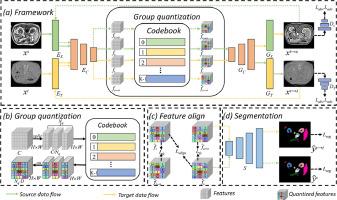腹部和前列腺分割中无监督域自适应的量化特征对齐
IF 3
3区 工程技术
Q2 ENGINEERING, ELECTRICAL & ELECTRONIC
引用次数: 0
摘要
无监督域自适应(UDA)在医学图像分割中起着至关重要的作用,特别是在没有带注释的目标域数据的情况下。传统的连续特征对齐方法由于小批量的限制而面临挑战,并且往往无法捕获完整的域分布。为了解决这些问题,我们提出了QFASeg-Net,这是一种新的UDA策略,利用量化特征对齐代替传统的连续方法。我们的分组量化技术将连续特征转换为离散表示,构建了一个逐步学习捕获域的整个特征分布的码本,而不是适应小批量内的有限分布。此外,我们结合多尺度高阶统计对齐来细化量化特征在不同域空间上的对齐,增强了跨域特征的一致性。在腹部和前列腺分割任务上的实验结果表明,QFASeg-Net优于现有方法,验证了量化特征对齐用于跨模态医学图像分割的有效性。本文章由计算机程序翻译,如有差异,请以英文原文为准。

Quantized feature alignment for unsupervised domain adaptation in abdominal and prostate segmentation
Unsupervised Domain Adaptation (UDA) plays a crucial role in medical image segmentation, especially when annotated target domain data is unavailable. Traditional continuous feature alignment methods face challenges due to mini-batch limitations and often fail to capture the full domain distribution. To address these issues, we propose QFASeg-Net, a novel UDA strategy that utilizes quantized feature alignment instead of conventional continuous approaches. Our grouped quantization technique transforms continuous features into discrete representations, constructing a codebook that progressively learns to capture the entire feature distribution of the domain, rather than adapting to the limited distributions within mini-batches. Moreover, we incorporate multi-scale high-order statistical alignment to refine the alignment of quantized features across different domain spaces, enhancing cross-domain feature consistency. Experimental results on abdominal and prostate segmentation tasks demonstrate that QFASeg-Net outperforms existing methods, validating the effectiveness of quantized feature alignment for cross-modality medical image segmentation.
求助全文
通过发布文献求助,成功后即可免费获取论文全文。
去求助
来源期刊

Digital Signal Processing
工程技术-工程:电子与电气
CiteScore
5.30
自引率
17.20%
发文量
435
审稿时长
66 days
期刊介绍:
Digital Signal Processing: A Review Journal is one of the oldest and most established journals in the field of signal processing yet it aims to be the most innovative. The Journal invites top quality research articles at the frontiers of research in all aspects of signal processing. Our objective is to provide a platform for the publication of ground-breaking research in signal processing with both academic and industrial appeal.
The journal has a special emphasis on statistical signal processing methodology such as Bayesian signal processing, and encourages articles on emerging applications of signal processing such as:
• big data• machine learning• internet of things• information security• systems biology and computational biology,• financial time series analysis,• autonomous vehicles,• quantum computing,• neuromorphic engineering,• human-computer interaction and intelligent user interfaces,• environmental signal processing,• geophysical signal processing including seismic signal processing,• chemioinformatics and bioinformatics,• audio, visual and performance arts,• disaster management and prevention,• renewable energy,
 求助内容:
求助内容: 应助结果提醒方式:
应助结果提醒方式:


